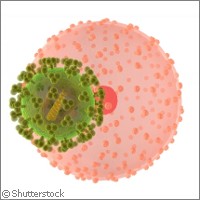New drug combats HIV in monkeys resistant to antiretroviral therapy
Researchers in Austria, the UK and the US have tested a new drug on monkeys infected with SIV, the simian form of the human immunodeficiency virus (HIV), and observed that it helped to reduce viral levels in animals that did not respond to antiretroviral therapy (ART). Their findings, published in the Journal of Immunology, provide encouraging evidence that the drug could be used in combination with ART to combat HIV/SIV infection. SIV is used to study the effects of potential treatments in animal models. Researchers observe the effect of different compounds on the viral load in the animals' blood; a higher load will usually lead to the onset of AIDS, wherein normally low-level infections cannot be fought off. In humans, highly active antiretroviral therapy (HAART) is currently used to reduce the patient's viral load and stave off the onset of AIDS. However, although this 'cocktail' of drugs substantially increases the life expectancy of many patients, it has proved to be ineffective in approximately 1 in 10 people. Current research efforts have focused on finding a way to boost the efficacy of the cocktail in HAART-resistant patients. 'HIV can have a devastating effect on people's lives but with advances in antiretroviral therapy it is becoming a more chronic, manageable disease,' said Dr Adriano Boasso of Imperial College London in the UK. 'Unfortunately, treatment does not work for everyone; some people develop resistance to the drugs and when that happens, we start to run out of options for treating them and delaying the onset of AIDS.' In this latest research, 19 rhesus macaques were infected with SIV. Of these, 11 were treated with ART for at least 4 months before being given daily doses of a modified amino acid called D-1mT for 2 weeks. They observed that in monkeys that did not respond to ART, D-1mT significantly reduced the virus level in the plasma and lymph nodes. The drug was not effective in animals that were not treated with ART. 'Our early findings suggest that D-1mT could be used alongside antiretroviral therapy to stop the virus from replicating,' said Dr Boasso. 'The disease can only progress if the virus is replicating, so if we can slow replication down we can reduce the impact of the disease on the patient's life. We still need to figure out how D-1mT is working; then we can think about developing this as a potential treatment for HIV.' The researchers assumed that D-1mT would reactivate the immune system because it can block the enzyme IDO, which HIV and SIV use to repress the immune system. In uninfected people, IDO normally prevents the immune system from attacking the body; HIV takes control of the machinery that produces IDO and effectively uses it to stop the immune system from attacking the virus. However, the researchers did not find evidence that D-1mT re-activated the immune response against SIV. 'The effect D-1mT seemed to have on viral load was really encouraging but it was a surprise to us,' said Dr Boasso. 'We didn't expect D-1mT to work only in macaques that were already being treated with ART. It seems that D-1mT synergises with ART, and we would really like to find out how this works.' Currently D-1mT is in clinical trials for its potential to treat cancer; the outcome of these trials should indicate whether D-1mT is suitable for humans. If the drug proves to be safe and shows further promise for treating HIV, it is possible that trials for the use of D-1mT in treating HIV could begin by 2015.
Countries
Austria, United Kingdom, United States



